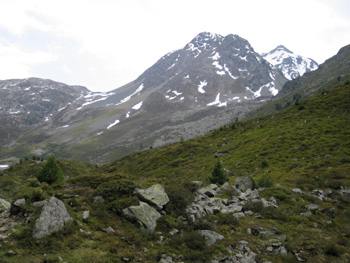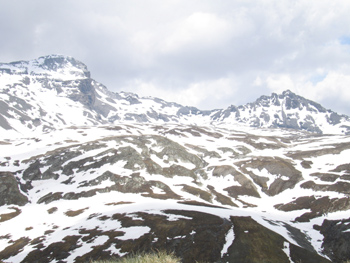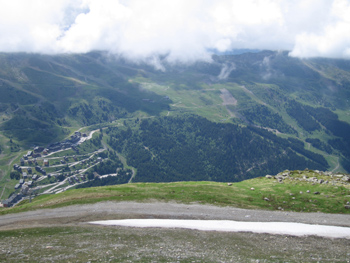
Real Birder
 |
Real Birder |
||||
| |
French Alps June 2005 |
| Introduction
On the morning of the 12th we had a short walk around the town, including several small parks. These yielded Serin, Swift, House Martin, Black Redstart and Spotted Flycatcher. Later in the morning we drove north through Aix-le-Bains, along Lac de Borget to the marsh and floodplain forest at the north end of the lake. 
This includes the Canal de Saviere, where Nightingale, Blackcap, Garden Warbler and Melodious Warbler sang in the woodland and willow scrub bordering the canal. We headed slightly further north to Mollard-Dessus, walking west to the banks of the River Rhone. This powerful stretch of river was very quiet with few waterfowl. Black Kites and Goosander were viewed. In the morning of the 13th we drove another 70km east to an apartment in the ski resort of Meribel-Mottaret. The resort lies at 1800 metres at the edge of the Vanoise National Park, designated for it's high alpine habitats. The resort also lies on the edge of the Tueda Nature Reserve, where skiing is prohibited. This has ensured the reserve has retained a great range of habitats, including the largest area of Arolla Pine in the French Alps. The resort and all its amenities were deserted, only opening for the summer season in July. We found our apartment at www.hiddenlimits.co.uk Week 1 Merribel–Mottaret
Walking west in dreadful weather to the Roc de Tougne gave views of male and female Black Grouse, Water Pipit, Ring Ouzel and Northern Wheatear. Heading east up to the summit of La Sauliere (a long but well surfaced climb of 1000 metres to 2700 metres) gave us great views of several approachable parties of Snowfinch, often viewed down to 20 feet. Walking south east up into the nature reserve was the highlight of the week. Walking up through the Arolla Pine, Nutcrackers abounded. At least 10 individuals were viewed at close range. This is the only woodland I have seen Nutcracker in the French Alps. This must be due to the high density of Arolla Pine, the Nutcracker's favourite feeding tree. We were out for 9 hours during this 15km walk. It was astonishingly beautiful and we saw only three people. Driving out from Meribel-Mottaret to Moutiers and then north-east on the N90, we found two Alpine Swifts feeding with other Swifts above the L'Isere River below Centron village. 
These were the only Alpine Swifts we saw during the fortnight. Red-backed Shrike and Tree Sparrow frequented the arable farmland between the river and the village. Continuing up the N90, we eventually passed through Val D'Isere and through Le Fornet. On the scree at the valley end, a family party of Chamoix was very approachable. A calling Rock Partridge remained invisible in the scree carpeted by Mountain Avens. A pair of Golden Eagle screamed over us. Driving further north-east eventually brought us to the 2700 metre pass of the Col de L'Iseran. This is the highest road in the French Alps, giving a breath-taking view over into Italy. 
Snowfinch and Water Pipit called from the scree at the roadside. Merribel-Mottaret is an engineered resort, criss-crossed by ski runs and lifts. Much of the mountain vegetation has been lost, cleared to produce good quality ski runs. However, the network of access tracks around and up the valley does make accessing the ridge tops on foot a simple process. Once the ski lifts open for the summer season (4th July onwards), ridge top access in all directions is even more simple. On the morning of the 18th, we packed up after a tiring but exciting 5 days walking. Heading north through Moutiers and Albertville, we arrived in Doussard at the southern edge of Lac D'Annecy, our base for the next week. We camped at the La Serraz campsite, operated by Eurocamp. Week 2 DoussardHaving stayed here in 2003 and 2004, this report focuses on some of the new sites and discoveries we made this year. (French Alps Trip Report June 2004)
On the 20th, we drove 10km east up the D508 to Ugine, then headed north up the Col de L'Arpettaz. Two short walks at the summit yielded Rock Thrush, Coal Tit, Northern Wheatear, Buzzard, Cuckoo, Water Pipit and Alpine Chough. Burnt Orchid, Great Yellow Gentian and Globe Flower abounded. Views up to Mont Blanc were also fantastic. We explored the Cormet de Roselend on the 21st. This 2000 metre road-crossed plateau lies 40km east of Doussard. Snowfinch, Water Pipit, Ring Ouzel and Rock Thrush were seen. The highlight of week 2 was a rapid ascent of the Col de Colombiere, 30km north of Doussard. Parking at the pass top restaurant, we headed up the mountain, getting immediate close views of 6 Citril Finch seed-feeding above the restaurant. After 15 minutes of climbing, we sat looking up to the summit. Over an hour, we were treated to good distant views of two Lammergeier. This mountain is one of sites where Lammergeier have been reintroduced to the Alps after their extinction during the last century.
Nick Mason |
| ©2012 Real Birder | Home • Photos • Trip Reports• Links • Contact Us |